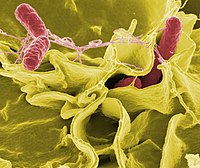
Photo from wikipedia
Salmonella species (spp.) are a major source of diarrheal diseases everywhere and one of the most dangerous foodborne bacteria. The present study aimed to detect the occurrence of the most… Click to show full abstract
Salmonella species (spp.) are a major source of diarrheal diseases everywhere and one of the most dangerous foodborne bacteria. The present study aimed to detect the occurrence of the most important virulence genes in Salmonella enterica (S. enterica) among bacteria isolated from stool in Baghdad hospitals, Iraq. In total, 50 swab stool samples were collected from patients suffering from food poisoning, attending to different hospitals in Baghdad. The isolates were identified using morphological tests and were confirmed by the Vitek-2 system (BioMe´rieux, France). A genomic DNA kit (Qiagen, Germany) was utilized to extract DNA from the isolates. Molecular detection of five virulence genes, including invA, papC, spvC, stn, and fimH, was performed using Polymerase Chain Reaction (PCR). Out of 50 swab samples, 40% (20 samples) were confirmed as S. enterica. Moreover, the prevalence of virulence genes determined by the PCR demonstrated that all 20 S. enterica isolates carried at least one gene from those associated with biofilm formation. The invA, stn, and fimH were the most predominant genes existing in all 20 S. enterica isolates. The prevalence of papC and spvC virulence genes was 75% (15 out of 20) and 65% (13 out of 20), respectively. The current data support the occurrence of Salmonella spp. exhibiting a broad range of virulence genes in stool samples from patients who had food poisoning, which indeed makes these bacteria a significant threat to public health.
Journal Title: Archives of Razi Institute
Year Published: 2022
Link to full text (if available)
Share on Social Media: Sign Up to like & get
recommendations!